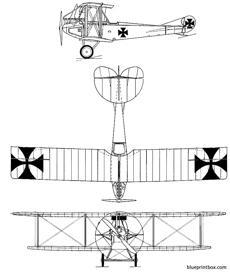In early 1917 the chief designer of this company, Julius von Berg designed the original multi-purpose airplane Aviatik-Berg CI. The C.I or "double Berg" was based on the D.I fighter. It used the same wings with a thin flexible profile, which varied depending on the speed of flight. Power was provided by either a 185 hp (138 kW) or 200 hp (149 kW) Austro-Daimler 6-cylinder water cooled in-line engine.
The test flights were generally successful. The top-notch pilots appreciated the speed and maneuverability of these machines. However, less skilled pilots preferred the more manageable, but less nimble, Hansa-Brandenburg C.I. One issue was the large wing loads putting stress on the aircraft and the C.I had a relatively high landing speed making landing on the short front-line runways difficult.
The C.I had a very reasonable performance and was built in considerable numbers by five several factories: Aviatik (Series 37 and 137), Lloyd (Series 47), Lohner (Series 114 and 214), WKF (Series 83 and 183) and MAG (Series 91) . In total more than 500 copies of the machine were built. Only its inherent structural weakness prevented it from receiving the acclamation that might otherwise have come its way. Nevertheless, it remained operational until the end of the war on the Italian-Austrian front.
Several schemes were used for armament on the C.I. Due to the urgent need for aircraft the first series were armed with one 0.315 in (8 mm) Schwarzlose machine gun fired by the pilot attached to a pivoting mount, fastened to the fuselage which allowed firing over the wing. There were versions which used a wing mounted "baby coffin" style gun pod. Some had a synchronized forward gun mounted in the fuselage, close to the engine. The observer fired into the rear arc with a ring mounted 0.315 in (8 mm) Schwarzlose machine gun.
The serial number scheme for Austro-Hungarian aircraft follows a format where the first numbers indicates the manufacturing company and production batch, while the numbers after the decimal point refers to the individual aircraft's place within the batch. Unlike the German system, there is no indication of the year in which construction took place
| Type |
2-seat reconnaissanse biplane |
| Engine |
1 Mercedes D III with a 2-bladed fixed pitch propeller |
| Dimensions |
Length 7,925 m, height 2,95 m, span 12,5 m, wing area 43 m2 |
| Weights |
Empty 750 kg, loaded 1340 kg , max. take off weight |
| Performance |
Max.speed 142 km/h, endurance 3 h, service ceiling 3500 m, time to 1000 m 12 min. |
| Type |
Werk.Nr |
Registration |
History |
|
|
|
"Vitello" |

